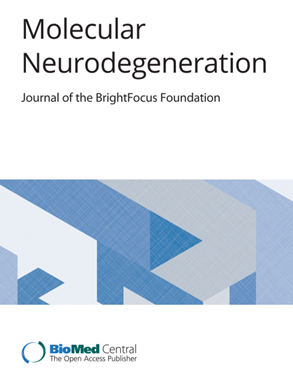Spectrum of γ-Secretase dysfunction as a unifying predictor of ADAD age at onset across PSEN1, PSEN2 and APP causal genes
IF 17.5
1区 医学
Q1 NEUROSCIENCES
引用次数: 0
Abstract
Autosomal Dominant Alzheimer's Disease (ADAD), caused by mutations in Presenilins (PSEN1/2) and Amyloid Precursor Protein (APP) genes, typically manifests with early onset (< 65 years). Age at symptom onset (AAO) is relatively consistent among carriers of the same PSEN1 mutation, but more variable for PSEN2 and APP variants, with these mutations associated with later AAOs than PSEN1. Understanding this clinical variability is crucial for understanding disease mechanisms, developing predictive models and tailored interventions in ADAD, with potential implications for sporadic AD. We performed biochemical assessment of γ-secretase dysfunction on 28 PSEN2 and 19 APP mutations, including disease-associated, unclear and benign variants. This analysis has been valuable in the assessment of PSEN1 variant pathogenicity, disease onset and progression. Our analysis reveals linear correlations between the molecular composition of Aβ profiles and AAO for both PSEN2 (R2 = 0.52) and APP (R2 = 0.69) mutations. The integration of PSEN1, PSEN2 and APP correlation data shows parallel but shifted lines, suggesting a common pathogenic mechanism with gene-specific shifts in onset. We found overall “delays” in AAOs of 27 years for PSEN2 and 8 years for APP variants, compared to PSEN1. Notably, extremely inactivating PSEN1 variants delayed onset, suggesting that reduced contribution to brain APP processing underlies the later onset of PSEN2 variants. This study supports a unified model of ADAD pathogenesis wherein γ-secretase dysfunction and the resulting shifts in Aβ profiles are central to disease onset across all causal genes. While similar shifts in Aβ occur across causal genes, their impact on AAO varies in the function of their contribution to APP processing in the brain. This biochemical analysis establishes quantitative relationships that enable predictive AAO modelling with implications for clinical practice and genetic research. Our findings also support the development of therapeutic strategies modulating γ-secretase across different genetic ADAD forms and potentially more broadly in AD.γ-分泌酶功能障碍谱作为PSEN1、PSEN2和APP致病基因中ADAD发病年龄的统一预测因子
常染色体显性阿尔茨海默病(ADAD)由早老素(PSEN1/2)和淀粉样前体蛋白(APP)基因突变引起,通常表现为早发(< 65岁)。症状发生年龄(AAO)在相同PSEN1突变的携带者中相对一致,但PSEN2和APP变体的差异更大,这些突变与PSEN1突变相比与晚期AAOs相关。了解这种临床变异性对于理解疾病机制、开发预测模型和针对ADAD的量身定制干预措施至关重要,对散发性AD具有潜在影响。我们对28个PSEN2和19个APP突变进行了γ-分泌酶功能障碍的生化评估,包括疾病相关的、不明确的和良性的突变。该分析在评估PSEN1变异致病性、发病和进展方面具有重要价值。我们的分析显示,PSEN2突变(R2 = 0.52)和APP突变(R2 = 0.69)中Aβ谱的分子组成与AAO之间存在线性相关。PSEN1、PSEN2和APP相关数据的整合显示出平行但移位的线条,提示具有基因特异性发病转移的共同致病机制。我们发现,与PSEN1相比,PSEN2和APP变体的aoo总体“延迟”时间分别为27年和8年。值得注意的是,极度失活的PSEN1变异体延迟了发病,这表明对大脑APP处理的贡献减少是PSEN2变异体延迟发病的基础。该研究支持了一种统一的ADAD发病机制模型,其中γ-分泌酶功能障碍和由此引起的a β谱变化是所有致病基因发病的核心。虽然Aβ在因果基因中也发生了类似的变化,但它们对AAO的影响在大脑中对APP处理的贡献功能上有所不同。这种生化分析建立了定量关系,使预测AAO模型具有临床实践和遗传研究的意义。我们的研究结果也支持了在不同的AD遗传形式中调节γ-分泌酶的治疗策略的发展,并可能更广泛地应用于AD。
本文章由计算机程序翻译,如有差异,请以英文原文为准。
求助全文
约1分钟内获得全文
求助全文
来源期刊

Molecular Neurodegeneration
医学-神经科学
CiteScore
23.00
自引率
4.60%
发文量
78
审稿时长
6-12 weeks
期刊介绍:
Molecular Neurodegeneration, an open-access, peer-reviewed journal, comprehensively covers neurodegeneration research at the molecular and cellular levels.
Neurodegenerative diseases, such as Alzheimer's, Parkinson's, Huntington's, and prion diseases, fall under its purview. These disorders, often linked to advanced aging and characterized by varying degrees of dementia, pose a significant public health concern with the growing aging population. Recent strides in understanding the molecular and cellular mechanisms of these neurodegenerative disorders offer valuable insights into their pathogenesis.
 求助内容:
求助内容: 应助结果提醒方式:
应助结果提醒方式:


